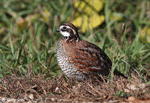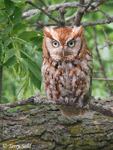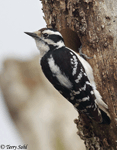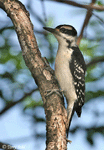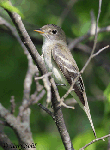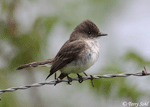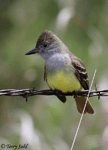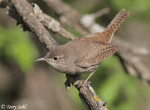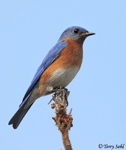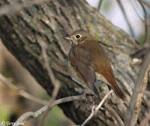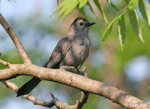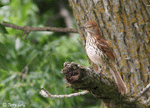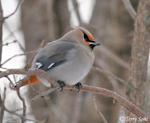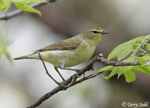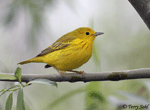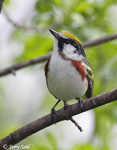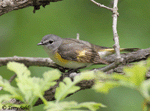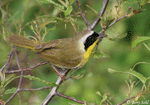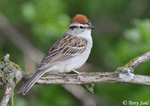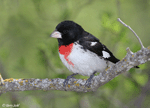South Dakota Birding Hotspot
Beaver Creek Nature Area
Minnehaha County
| Click on points to view actual ground photos and birding information for those locations. Use the Google tools to switch between road maps, terrain, or satellite images. |
Directions:
Beaver Creek Nature Area is about 10 miles east of Sioux Falls, or about 2 miles east of Brandon. The easiest access is to take Highway 11 south out of Brandon. In less than a mile, you'll see Madison Street headed east. Drive just past Madison Street and you'll see a seasonal vegetable stand on the SE corner of a partial intersection. Turn left (east) and take that gravel road (labeled 264th Street) eastward for about 2 1/2 miles. You'll see the entrance to Beaver Creek Nature Area on your right.
Geographic Coordinates: 43.558336° N, 96.542199 W (coordinate of entrance road).
Description:
Beaver Creek Nature Area is a protected area of 165 acres just east of the city of Brandon. For a birder, the attraction is a variety of habitats, included some very nice mature forest lands that can be otherwise hard to find in the area. Beaver Creek is a small creek meandering through the heart of the Nature Area. The small, shallow prairie stream is bordered with riparian lowland forest (Cottonwood, Willows, Box Elder, and other tree species). Both the creek itself and the surrounding riparian zone offer great habitat for a variety of birds and other wildlife. On the hills on the south side of the creek is mature upland forest, dominated by Burr Oak but also with Linden, Hackberry, and other trees. The north side of the river is primarily open grassland. Beaver Creek was once native tallgrass prairie, dominated by Big Bluestem, Switchgrass, and Indian Grass, but much of the remaining grassland is now non-native species, with scattered native grasses and flowers.
Beaver Creek has a very nice trail system, and despite the proximity to Sioux Falls, there are rarely many visitors to the area outside of "Homesteader Days", right after Labor Day. On most visits to the park, a birder will find themselves alone, or perhaps you will occasionally pass another visitor on a trail. With the lack of camping facilities, Beaver Creek is always much less busy than the nearby Big Sioux Recreation Area, and a birder won't have to worry about interruptions that may disrupt their birding experience. A very nice trail system is found at Beaver Creek, taking a hiker through meadows, riparian areas, and upland forest. Click here to access a trail map for Beaver Creek Nature Area.
Points of Note (Click on numbers on the map to see photos of the locations)::
Beaver Creek Nature Area has an excellent trail system that provides a birder with access to all the varieties of habitat within the park. Three different parking areas are found in the park, with both southern parking lots offering close access to the trails. I always park at the southwestern parking lot (near the old Samuelson log cabin, a family home built back in 1872). From the southwestern parking lot, a trail heads southwest along the edge of the creek and riparian trees, to a suspension bridge that crosses the creek. The area around the bridge can offer excellent birding (Point 1 on the map). Watch the trees for songbirds, and be prepared for the rattling calls of a pair of Belted Kingfishers that always seem to be around.
Point 2 is found just past the bridge. As you cross the bridge, you'll enter an open brushy meadow with scattered small trees. When I first moved to South Dakota in 1993, this area was more open than it is now, but in subsequent years small locust and other trees have sprouted and been allowed to grow. The once open meadow is on the path to becoming more of a woodland, but it still offers great birding. The proximity to the creek and the taller trees on the nearby ridge means you'll often find songbirds in this area, moving back and forth between the two areas. It's also an area where I've seen Northern Bobwhite (Beaver Creek is the ONLY place I've come across Northern Bobwhite in South Dakota to date). Field Sparrows love this area, and it's also a spot where I've seen Black-billed Cuckoo feeding on tent caterpillars that are often in the small trees here. As you walk through the brushy meadow on the path, you'll hit a T-intersection. If you follow the left (east) fork, the trail will move up a ridge. At the edge of the brushy meadow, near the top of the ridge, the open area meets mature Burr Oak forest. This location, on the ridge top as you leave the brushy meadow, is one of my favorite spring birding locations in the entire region. Given the topography, you're almost at canopy level with some of the Burr Oaks that line the creek below, but you're also on the forest edge. The spot can offer simply spectacular views of migrating warblers and other songbirds in the spring. Given the location on the ridgeline, next to the creek, there are times I'll sit here for multiple hours, watching wave after wave of songbird move through the canopy.
Point 3 represents the heart of the largely forested trail that goes through the southwestern quarter of the park. The trail forms a loop here, starting and ending at the bench and T-intersection found in the heart of the "brushy meadow" at Point 2. As noted above, the trail climbs as you move out of the brushy meadow and into the forest. For much of the trail as you loop around, you'll be in upland forest. Parts of the trail skirt the edge of the forest, offering opportunities to see edge-dependent species. However, much of the trail moves through the heart of mature upland forest land. I've seen more Eastern Screech Owls at Beaver Creek Nature Area than I have in the rest of South Dakota combined, and this forested trail is one area they're found. At the far western end, the trail starts to move downslope again towards the creek. The last section of the trail as you loop back towards the T-intersection is along thick lowland forest along the creek itself. The lowland area is a nice spot to walk through in spring and early summer, as many times you'll hear Ovenbirds and Wood Thrush singing.
Point 4 is the the road itself that leads to Beaver Creek. The east/west gravel road that runs from Highway 11 on the west to Beaver Creek is labeled as 264th street, but locally it is called "Spook Road". As you head east from Highway 11 towards Beaver Creek, Spook Road crosses small creeks several times, passing through pockets of trees and other riparian vegetation. Given that the vast majority of gravel roads in South Dakota pass through wide open expanses of cropland or grassland, it's a definite departure from the norm. The woody vegetation along the road can be great for songbirds. Note that in recent years, Minnehaha County has started to remove quite a bit of the roadside vegetation, citing a safety hazard of trees so close to the road itself. In the areas where the roadside trees have been removed, birding has significantly declined in quality.
Birds of Note:
A birding trip to Beaver Creek (and the nearby Spook Road) is typically to look for songbirds. With both lowland riparian forest and upland forest, as well as grassy open patches that offer a lot of edge habitat, the variety of songbirds you may potentially see is quite high. The best time to visit the park is May, when migration is in full swing. Particularly around the middle of the month, you'll have both the arrival of the typical summer breeding birds, as well as many neotropical migrants moving through. The spring warbler migration is sometimes hit or miss in eastern South Dakota, but when it's "on", birding at Beaver Creek can be spectacular. On the one ridgetop mentioned in conjunction with Point 2, I've had days where 15 or more warbler species, along with other songbirds, may be moving through the ridgetop canopy of Burr Oaks. Warbler species mimic those typically found in eastern South Dakota in the Spring. Overall during the spring migration, Yellow-rumped, Tennessee, and Orange-crowned Warblers are usually the most common. Common Yellowthroats and Yellow Warblers are common breeders that will also be found at Beaver Creek throughout the summer. American Redstarts and Ovenbirds also staying to breed. Palm, Magnolia, Black-and-White, and Wilson's Warblers are some of the somewhat less common migrants that are still usually found in small numbers. However, every spring there are always some of the less common warblers mixed in. Other species I've seen at Beaver Creek are Golden-winged, Black-throated Green, Blackpoll, Canada, Nashville, Chestnut-sided, and Cape May Warblers, as well as Northern Parula and Northern Waterthrush.
While springtime warblers are a great attraction, there are also many other songbirds that either migrate through in the spring, or breed at Beaver Creek in the summer. During the spring migration, you could see as many as six Vireo species in a given day. Philadelphia and Blue-headed Vireos are migrants, while Red-eyed, Yellow-throated, Warbling, and Bell's Vireo all may breed here (the latter two being less common that the first two). Flycatchers are also common migrants, with several of the confusing Empidonax flycatchers moving through, while Eastern Wood-Pewees, Eastern Phoebe, Great Crested Flycatcher, and Eastern Kingbird all are local breeders. Hermit, Swainson's, and Gray-cheeked Thrush all migrate through Beaver Creek, while Wood Thrush are sometimes found as breeders. As with most of South Dakota, spring and fall migration may bring a wide variety of sparrow species to the area.
Summer breeding birds are typical of those found in eastern forests of the U.S. (with many thus somewhat hard to find in eastern South Dakota). Several species of woodpeckers breed at Beaver Creek, with Red-bellied, Hairy, Downy, and Red-headed Woodpeckers, along with Northern Flicker and Yellow-bellied Sapsucker, all quite common. Rose-breasted Grosbeaks, Indigo Buntings, Eastern Bluebirds, Baltimore Oriole, Northern Cardinal, Brown Thrasher, and Cedar Waxwings are also usually quite common. Less common but sometimes seen breeding birds include Blue Grosbeak, Scarlet Tanager, and Blue-gray Gnatcatcher. Beaver Creek (and Spook Road) are where I've had my best luck in the area in find Cuckoos, most often Black-billed, but I've also seen Yellow-billed Cuckoos here.
While songbirds are the biggest attraction for me, Beaver Creek also is a terrific location to look for Eastern Screech Owls (including what seems to be a booming population of the "red-phase" owls that are rarer in South Dakota) and Great Horned Owls. Common raptors are Cooper's Hawk, Sharp-shinned Hawk (winter), Red-tailed Hawk, and even Bald Eagle (a nesting location is about 3 miles away). I don't see Northern Goshawks around the area very often, but have seen them here on multiple occasions in the winter. While not the major draw for birders visiting Beaver Creek, the creek itself sometimes hold wading birds (primarily Great Blue Heron and Green Heron) or shorebirds.
Other Birding Locations (sorted by distance):
- Big Sioux Recreation Area (~4 miles)
- Good Earth State Park (~15 miles)
- Outdoor Campus in Sioux Falls (~20 miles)
- Newton Hills State Park (~30 miles)
- Dewey Gevik / Wall Lake (~30 miles)
- Western Minnehaha County (~35 miles)
- Madison Waterfowl Production Area (~55 miles)
- Dakota Nature Park (~65 miles)
- North Alabama Bend (~75 miles)
- Lake Thompson Area (~90 miles)
- Gavin's Point Dam (~95 miles)
- Presho Area (~180 miles)
- Fort Pierre National Grasslands (~200 miles)
- Pierre / Oahe Dam Area (~230 miles)
- LaCreek National Wildlife Refuge (~310 miles)
